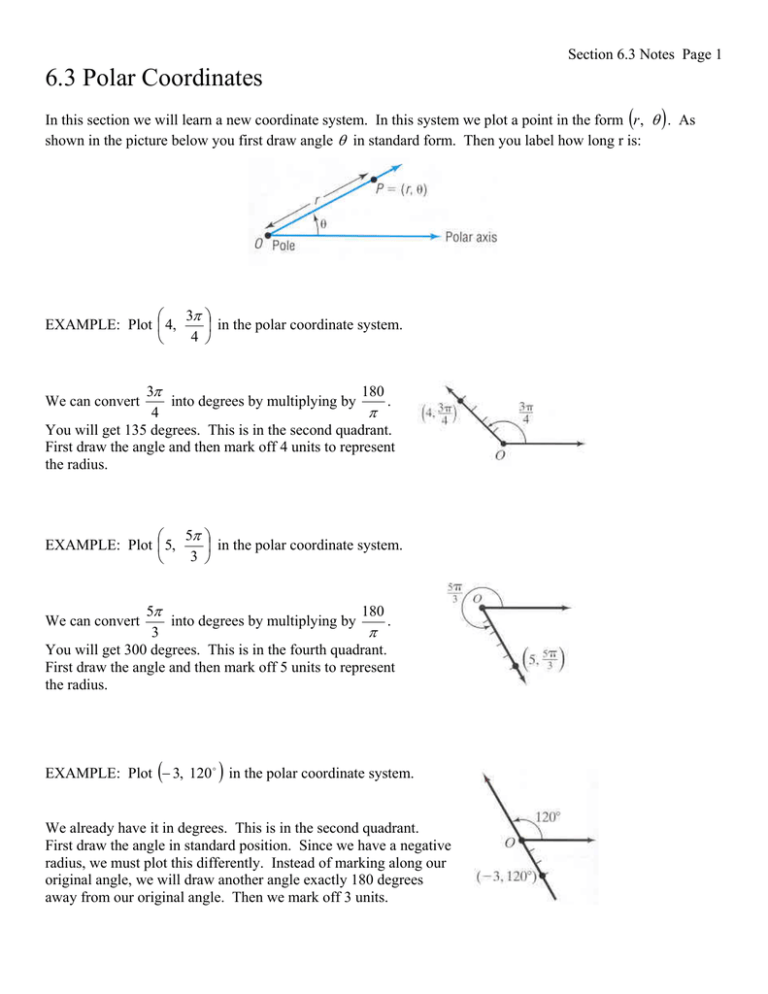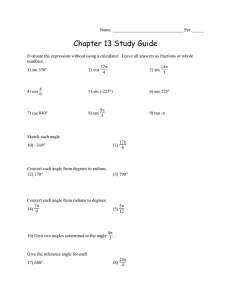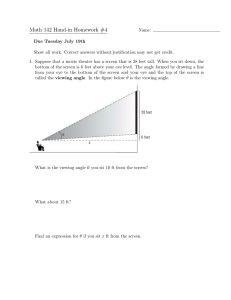6.3 Polar Coordinates
advertisement

Section 6.3 Notes Page 1 6.3 Polar Coordinates In this section we will learn a new coordinate system. In this system we plot a point in the form r , . As shown in the picture below you first draw angle in standard form. Then you label how long r is: 3 EXAMPLE: Plot 4, in the polar coordinate system. 4 180 3 . into degrees by multiplying by 4 You will get 135 degrees. This is in the second quadrant. First draw the angle and then mark off 4 units to represent the radius. We can convert 5 EXAMPLE: Plot 5, in the polar coordinate system. 3 180 5 into degrees by multiplying by . 3 You will get 300 degrees. This is in the fourth quadrant. First draw the angle and then mark off 5 units to represent the radius. We can convert EXAMPLE: Plot 3, 120 in the polar coordinate system. We already have it in degrees. This is in the second quadrant. First draw the angle in standard position. Since we have a negative radius, we must plot this differently. Instead of marking along our original angle, we will draw another angle exactly 180 degrees away from our original angle. Then we mark off 3 units. Section 6.3 Notes Page 2 EXAMPLE: Plot 3, in the polar coordinate system. 2 We need to convert this into degrees by multiplying by 180 . You will get -90 degrees. First draw the angle in standard position. Remember that negative angles are drawn clockwise in standard position. Since we have a negative radius instead of marking along our original angle, we will draw another angle exactly 180 degrees away from our original angle. Then we mark off 3 units. 3 EXAMPLE: Plot 3, in the polar coordinate system. 4 We need to convert this into degrees by multiplying by 180 . You will get -135 degrees. First draw the angle in standard position. Remember that negative angles are drawn clockwise in standard position. Since we have a negative radius instead of marking along our original angle, we will draw another angle exactly 180 degrees away from our original angle. Then we mark off 3 units. Equivalent Angles There are more than one way to arrive at the same angle. For example in the previous problem, -135 degrees is the same as 360 135 225 . If we have 120 degrees then this is the same as 120 360 240 . So for negative angles, just add 360 degrees. For positive angles add negative 360 degrees to find the equivalent angle. So basically we can either move clockwise or counterclockwise to arrive at the same angle. r , r , 2 or r , r , 360 r , r , or r , r , 180 EXAMPLE: Given the polar coordinate 5, 300 , find an equivalent polar coordinate that has the following characteristics: a.) 360 0 , r > 0 b.) 0 360 , r < 0, c.) 360 720 , r > 0 a.) In this problem we are told to work in degrees. We want an angle that is negative that will lead us to the same point. We are allowed to add or subtract a 360 and that won’t change our problem. So we can do 300 360 60 . This is an equivalent angle. So our equivalent point is 5, 60 . Our r is positive, so we are done. b.) Now we want r to be negative. The formula above r , r , 180 tells us that we can add a 180 degrees to our angle and this will change the r to a –r. Now if we add 180 degrees then we will get an angle more than 360 degrees, so we must subtract 180 degrees: 300 180 120 . Our equivalent point is: 5, 120 . Section 6.3 Notes Page 3 c.) We want r to be positive and we need an angle that is more than one revolution, so we just need to add 360 to our angle: 300 360 660 . Our equivalent point is: 5, 660 . 3 EXAMPLE: Given the polar coordinate 4, , find an equivalent polar coordinate that has the following 4 characteristics: a.) 2 0 , r > 0 b.) 0 2 , r < 0, c.) 2 4 , r > 0 a.) In this problem we are told to work in radians. We want an angle that is negative that will lead us to the same point. We are allowed to add or subtract a 2 and that won’t change our problem. So we can do 3 5 5 2 . This is an equivalent angle. So our equivalent point is 4, . Our r is positive, so we 4 4 4 are done. b.) Now we want r to be negative. The formula above r , r , tells us that we can add a pi to our angle and this will change the r to a –r. Now if we subtract a pi then we will get a negative angle, and our 3 7 . Adding the pi question tells us we must have a positive angle, so we will add pi to our angle: 4 4 7 will change our r to a negative r, so our equivalent point is: 4, . 4 c.) We want r to be positive and we need an angle that is more than one revolution, so we just need to add a 2 3 11 11 to our angle: 2 . Our equivalent point is: 4, . 4 4 4 EXAMPLE: Given the polar coordinate 2, 120 , find an equivalent polar coordinate that has the following characteristics: a.) 360 0 , r > 0 b.) 0 360 , r < 0, c.) 360 720 , r > 0 a.) For this problem we are working all in degrees. We want an angle that is negative but an r that is positive. Our formula says that we can either add or subtract 180 from our original angle. If we add 180 then we won’t have a negative angle anymore so we need to subtract: 120 180 300 . Now we have the equivalent point: 2, 300 . b.) We already have a negative r. Now we need a positive angle. We don’t want to change r, so we need to add 360 to our original angle: 120 360 240 . So our equivalent point is: 2, 240 . c.) We need r to be positive and our angle needs to be 360 720 . We need to add 180 to change the r into a negative r. 120 180 60 . We are not done yet because this is not between 360 degrees and 720 degrees. We can add 360 degrees and this won’t change our r: 60 360 420 . Section 6.3 Notes Page 4 Conversion formulas from polar to rectangular coordinates. x r cos y r sin x2 y2 r 2 EXAMPLE: Convert 5, into a rectangular point. 3 We can use the above formulas and plug in a 5 for r and a 3 for . We will have: x 5 cos 3 . This equals: 3 5 3 1 3 x 5 . Now we will find y: y 3 sin . This equals: y 5 . So our rectangular point is 3 2 2 2 2 5 5 3 , 2 2 EXAMPLE: Convert 3, into a rectangular point. 4 for . We will have: x 3 cos . This 4 4 2 3 2 2 3 3 equals: x 3 . Now we will find y: y . This equals: y 3 3 sin 2 2 . 2 2 4 3 2 3 2 . So our rectangular point is , 2 2 We can use the above formulas and plug in a -3 for r and a 2 EXAMPLE: Convert 2, into a rectangular point. 3 2 2 for . We will have: x 2 cos . This 3 3 3 2 1 3 . So our equals: x 2 1 . Now we will find y: y 2 sin . This equals: y 2 3 2 2 rectangular point is 1, 3 . We can use the above formulas and plug in a -2 for r and a EXAMPLE: Convert the equation r 1 sin into a rectangular equation. First let’s multiply the both sides of the equation by r. This will allow us to put in substitutions for the sine: r 2 r r sin . Now we will replace the r 2 with x 2 y 2 and we can replace the r sin with y. Then we have: x 2 y 2 x 2 y 2 y . There is nothing more we can do with this. Section 6.3 Notes Page 5 EXAMPLE: Convert the equation r 4 into a rectangular equation. We can square both sides by r to get: r 2 16 . So x 2 y 2 16 , which is a circle. EXAMPLE: Convert the equation r 3 into a rectangular equation. 3 cos First we can cross multiply to get: 3r r cos 3 . Now replace the r with x 2 y 2 and replace the r cos with an x: 3 x 2 y 2 x 3 . Not much more to do here. EXAMPLE: Convert the equation r 2 sin 4 cos into a polar equation. First let’s multiply the both sides of the equation by r. This will allow us to put in substitutions for the sine and cosine: r 2 2r sin 4r cos . Now we will replace the r 2 with x 2 y 2 and we can replace the r sin with y and the r cos with x. Then we have: x 2 y 2 2 y 4 x . On the quiz and test this type of question will be given as multiple choice. You would notice that our answer above would not appear as one of the choices. There is more we can do with this one. First set it equal to zero and group all the x and y terms together: x 2 4 x y 2 2 y 0 . Now we can complete the square on both sides: x 2 4 x 4 y 2 2 y 1 0 4 1 . Now we factor and our answer is: ( x 2) 2 y 1 5 . This is a circle. 2 Conversion formulas from rectangular to polar coordinates x2 y2 r 2 If (x, y) is in the first or fourth quadrant, then tan 1 y . x If (x, y) is in the second or third quadrant, then tan 1 y . x EXAMPLE: Convert 3, 3 into a polar coordinate. Express your angle in radians. We can use the above formulas and plug in a -3 for x and a 3 for y. This will give us r: (3) 2 (3) 2 r 2 . This will give us r 3 2 . If we plot 3, 3 we will end up in the second quadrant. So we will use 3 3 y tan 1 , so tan 1 . This equals: . So our polar coordinates are x 4 4 3 3 3 2, . 4 Section 6.3 Notes Page 6 EXAMPLE: Convert 2, 2 3 into a polar coordinate. Express your angle in radians. We can use the above formulas and plug in a -2 for x and a 2 3 for y. This will give us r: (2) 2 2 3 2 r 2 . This will give us r 2 4 12 , so r = 4. If we plot 2, 2 3 we will end up in the third quadrant. So we will use tan 1 4 our polar coordinates are 4, . 3 2 3 4 y , so tan 1 . This equals: . So 2 x 3 3 1 3 into a polar coordinate. Express your angle in radians. EXAMPLE: Convert , 2 2 We can use the above formulas and plug in a 1 3 for y. This will give us r: for x and a 2 2 2 2 1 3 3 1 3 1 we will end up in the r 2 . This will give us r 2 , so r = 1. If we plot , 2 4 4 2 2 2 3 y fourth quadrant. So we will use tan 1 , so tan 1 2 . This equals: tan 1 3 . Therefore, 1 x 2 . So our polar coordinates are 1, . 3 3 EXAMPLE: Convert the equation x 2 y 2 x into a polar equation. In this equation we will replace x 2 y 2 with r 2 and we will replace x with r cos . We get: r 2 r cos . We need to set this equal to zero and solve for r. We will get: r 2 r cos 0 . Now factor out an r: r (r cos ) 0 . Solving for r we get: r 0 and r cos . EXAMPLE: Convert the equation 4 x 2 y 1 into a polar equation. In this equation we will replace x 2 with r 2 cos 2 and we will replace y with r sin . We get: 4r 2 cos 2 r sin 1 . This equals 4r 3 cos 2 sin 1 . Can’t do much more with this. EXAMPLE: Convert the equation y 2 2 x into a polar equation. In this equation we will replace y 2 with r 2 sin 2 and we will replace x with r cos . You will get: r 2 sin 2 2r cos . On the quiz and test this type of question will be given as multiple choice. You would notice that our answer above would not appear as one of our choices. That means we need to simplify this Section 6.3 Notes Page 7 further. First set this equal to zero: r sin 2r cos 0 . Now factor our an r: r (r sin 2 2 cos ) 0 . Now set both factors equal to zero. You will get r = 0 and r sin 2 2 cos 0 . We need to solve the second 1 2 cos cos equation for r. You will get: r . Then our final answer . This can be written as: r 2 2 sin sin sin is r 2 cot csc . 2 2





